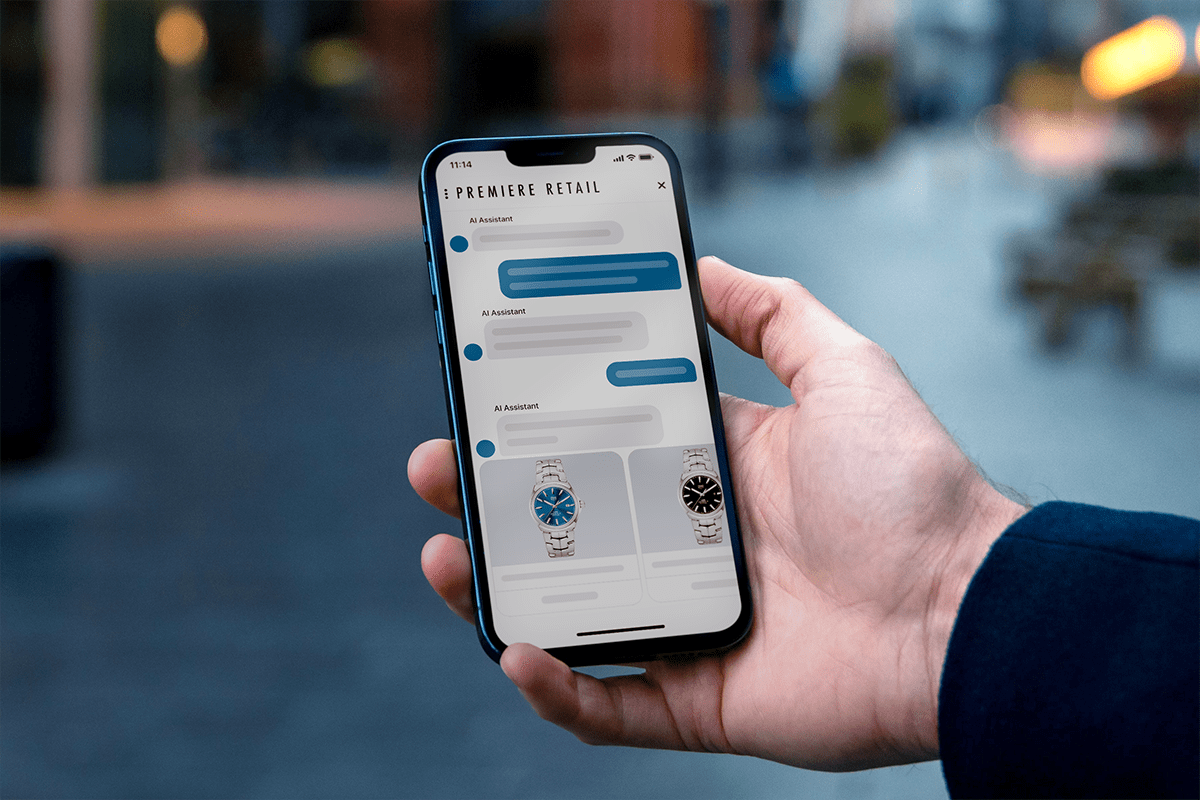Businesses have always turned to the latest and greatest technology to better serve their customers, and retail is no different. From early credit card payment systems to the latest in online advertising, retailers know that they need to take advantage of new tools to boost their profits and keep shoppers happy.
These days, the thing that’s on everyone’s mind is artificial intelligence (AI). AI has had many, many definitions over the years, but in this article, we’ll mainly focus on the machine-learning and deep-learning systems that have captured the popular imagination. These include large language models, recommendation engines, basic AI assistants, etc.
In the world of AI in retail, you can broadly think of these systems as falling into one of two categories: “the ones that customers see”, and “the ones that customers don’t see.” In the former category, you’ll find innovations such as customer-facing chatbots and algorithms that offer hyper-personalized options based on shopping history. In the latter, you’ll find precision fraud detection systems and finely-tuned inventory management platforms, among other things.
We’ll cover each of these categories, in order. By the end of this piece, you’ll have a much better understanding of the ways retailers are using AI assistants and will be better able to think about how you want to use this technology in your retail establishment.
Let’s get going!
Using AI Assistants for Better Customer Experience
First, let’s start with AI that interacts directly with customers. The major ways in which AI is transforming the customer experience are through extreme levels of personalization, more “humanized” algorithms, and shopping assistants.
Personalization in Shopping and Recommendations
One of the most obvious ways of improving the customer experience is by tailoring that experience to each individual shopper. There’s just one problem: this is really difficult to do.
On the one hand, most of your customers will be new to you, people about whom you have very little information and whose preferences you have no good way of discovering. On the other, there are the basic limitations of your inventory. If you’re a brick-and-mortar establishment you have a set number of items you can display, and it’s going to be pretty difficult for you to choose them in a way that speaks to each new customer on a personal level.
For a number of reasons, AI has been changing this state of affairs for a while now, and holds the potential to change it much more in the years ahead.
A key part of this trend is recommendation engines, which have gotten very good over the past decade or so. If you’ve ever been surprised by YouTube’s ability to auto-generate a playlist that you really enjoyed, you’ve seen this in action.
Recommendation engines can only work well when there is a great deal of customer data for them to draw on. As more and more of our interactions, shopping, and general existence have begun to take place online, there has arisen a vast treasure trove of data to be analyzed. In some situations, recommendation engines can utilize decades of shopping experience, public comments, reviews, etc. in making their recommendations, which means a far more personalized shopping experience and an overall better customer experience.
What’s more, advances in AR and VR are making it possible to personalize even more of these experiences. There are platforms now that allow you to upload images of your home to see how different pieces of furniture will look, or to see how clothes fit you without the need to try them on first.
We expect that this will continue, especially when combined with smarter printing technology. Imagine getting a 3D-printed sofa made especially to fit in that tricky corner of your living room, or flipping through a physical magazine with advertisements that are tailored to each individual reader.
Humanizing the Machines
Next, we’ll talk about various techniques for making the algorithms and AI assistants we interact with more convincingly human. Admittedly, this isn’t terribly important at the present moment. But as more of our shopping and online activity comes to be mediated by AI, it’ll be important for them to sound empathic, supportive, and attuned to our emotions.
The two big ways this is being pursued at the moment are chatbots and voice AI.
Chatbots, of course, will probably be familiar to you already. ChatGPT is inarguably the most famous example, but you’ve no doubt interacted with many (much simpler) chatbots via online retailers or contact centers.
In the ancient past, chatbots were largely “rule-based”, meaning they were far less flexible and far less capable of passing as human. With the ascendancy of the deep learning paradigm, however, we now have chatbots that are able to tutor you in chemistry, translate between dozens of languages, help you write code, answer questions about company policies, and even file simple tickets for contact center agents.
Naturally, this same flexibility also means that retail managers must tread lightly. Chatbots are known to confidently hallucinate incorrect information, to become abusive, or to “help” people with malicious projects, like building weapons or computer viruses.
Even leaving aside the technical challenges of implementing a chatbot, you have to carefully monitor your chatbots to make sure they’re performing as expected.
Then, there’s voice-based AI. Computers have been synthesizing speech for many years, but it hasn’t been until recently that they’ve become really good at it. Though you can usually tell that a computer is speaking if you listen very carefully, it’s getting harder and harder all the time. We predict that, in the not-too-distant future, you’ll simply have no idea whether it’s a human or a machine on the other end of the line when you call to return an item or get store hours.
But computers have also gotten much better at the other side of voice-based AI, speech recognition. Software like otter.ai, for example, is astonishingly accurate when generating transcriptions of podcast episodes or conversations, even when unusual words are used.
Taken together, advances in both speech synthesis and speech recognition paint a very compelling picture of how the future of retail might unfold. You can imagine walking into a Barnes & Noble in the year 2035 and having a direct conversation with a smart speaker or AI assistant. You’ll tell it what books you’ve enjoyed in the past, it’ll query its recommendation system to find other books you might like, and it’ll speak to you in a voice that sounds just like a human’s.
You’ll be able to ask detailed questions about the different books’ content, and it’ll be able to provide summaries, discuss details with you, and engage in an unscripted, open-ended conversation. It’ll also learn more about you over time, so that eventually it’ll be as though you have a friend that you go shopping with whenever you buy new books, clothing, etc.
Shopping Assistants and AI Agents
So far, we’ve confined our conversation specifically to technologies like large language models and conversational AI. But one thing we haven’t spent much time on yet is the possibility of creating agents in the future.
An agent is a goal-directed entity, one able to take an instruction like “Make me a reservation at an Italian restaurant” and decompose the goal into discrete steps, performing each one until the task is completed.
With clever enough prompt engineering, you can sort of get agent-y behavior out of ChatGPT, but the truth is, the work of building advanced AI agents has only just begun. Tools like AutoGPT and LangChain have made a lot of progress, but we’re still a ways away from having agents able to reliably do complex tasks.
It’s not hard to see how different retail will be when that day arrives, however. Eventually, you may be outsourcing a lot of your shopping to AI assistants, who will make sure the office has all the pens it needs, you’ve got new science fiction to read, and you’re wearing the latest fashion. Your assistant might generate new patterns for t-shirts and have them custom-printed; if LLMs get good enough, they’ll be able to generate whole books and movies tuned to your specific tastes.
Using AI Assistants to Run A Safer, Leaner Operation
Now that we’ve covered the ways AI assistants will impact the things customers can see, let’s talk about how they’ll change the things customers don’t see.
There are lots of moving parts in running a retail establishment. If you’ve got ~1,000 items on display in the front, there are probably several thousand more items in a warehouse somewhere, and all of that has to be tracked. What’s more, there’s a constant process of replenishing your supply, staying on top of new trends, etc.
All of this will also be transformed by AI, and in the following sections, we’ll talk about a few ways in which this could happen.
Fraud Detection and Prevention
Fraud, unfortunately, is a huge part of modern life. There’s an entire industry of people buying and selling personal information for nefarious purposes, and it’s the responsibility of anyone trafficking in that information to put safeguards in place.
That includes a large number of retail establishments, which might keep data related to a customer’s purchases, their preferences, and (of course) their actual account and credit card numbers.
This isn’t the place to get into a protracted discussion of cybersecurity, but much of fraud detection relies on AI, so it’s fair game. Fraud detection techniques range from the fairly basic (flagging transactions that are much larger than usual or happen in an unusual geographic area) to the incredibly complex (training powerful reinforcement learning agents that constantly monitor network traffic).
As AI becomes more advanced, so will fraud detection. It’ll become progressively more difficult for criminals to steal data, and the world will be safer as a result. Of course, some of these techniques are also ones that can be used by the bad guys to defraud people, but that’s why so much effort is going into putting guardrails on new AI models.
Streamlining Inventory
Inventory management is an obvious place for optimization. Correctly forecasting what you’ll need and thereby reducing waste can have a huge impact on your bottom line, which is why there are complex branches of mathematics aimed at modeling these domains.
And – as you may have guessed – AI can help. With machine learning, extremely accurate forecasts can be made of future inventory requirements, and once better AI agents have been built, they may even be able to automate the process of ordering replacement materials.
Forward-looking retail managers will need to keep an eye on this space to fully utilize its potential.
AI Assistants and the Future of Retail
AI is changing a great many things. It’s already making contact center agents more effective and is being utilized by a wide variety of professionals, ranging from copywriters to computer programmers.
But the space is daunting, and there’s so much to learn about implementing, monitoring, and finetuning AI assistants that it’s hard to know where to start. One way to easily dip your toe in these deep waters is with the Quiq Conversational CX platform.
Our technology makes it easy to create customer-facing AI bots and similar tooling, which will allow you to see how AI can figure into your retail enterprise without hiring engineers and worrying about the technical details.
Schedule a demo with us today to get started!



